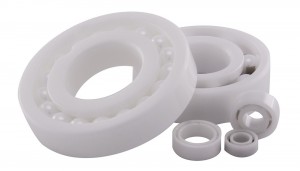Full Ceramic Ball Bearings have Rings and Balls that are constructed of Ceramic material. These bearings may be better suited for certain applications better than their stainless steel counterparts – specifically in situations where there is a harsh environment where stainless steel would not survive or in situations where magnetism is of concern (ceramics are non-magnetic.) Applications such as cryopumps, medical devices, semiconductors, machine tools, turbine flow meters, food processing equipment, robotics and laboratory equipment. Ceramic materials commonly used for bearings are Silicon Nitride (Si3N4) and Zirconia Oxide (ZrO2).
Full ceramic ball bearings can continue to operate under extremely high temperatures and are capable of operating up to 1472 Deg. F. Ceramic is much lighter than steel and many bearings are 1/3 the weight of a comparable steel bearing. Full ceramic bearings are highly corrosion resistant and will stand up to most common acids, they will not corrode in exposure to water or salt water. And finally full ceramic ball bearings are non-conductive.
Radial Full Ceramic Ball Bearings are Suitable for the following applications:
- High corrosion resistance
- Qualify for extreme temperatures
- Qualify for dry running conditions
- Low weight
- Absolutely Non-magnetic
- Qualify for media- and starved lubrication
- High stiffness
- High reliability
- Low abrasion
- Low operating costs
Full Ceramic Bearings for Extreme Applications
|
CERAMIC VS. STEEL |
||||
|
Item |
Bearing Steel |
Ceramics (SI3N4) |
Characteristics of Ceramic Bearings |
|
|
Density (g/m?) |
7.8 |
3.2 |
Higher Speed Decreased centrifugal force Reduced Ball Skidding Lower Operating Temperature Less wear Less Friction |
|
|
Heat Resistance (ºC) |
180 |
800 |
Maintains stability at high temperatures |
|
|
Coefficient of linear thermal expansion (1/ºC) |
12.5 X 10-6 |
3.2 X 10-6 |
Minimal Ball Deformation Lower operating Temperature Stable Running Preload Reduced Contact Angle Change |
|
|
Vicker’s Hardness (HV) |
750 |
1,500 |
Reduced Ball/Race Contact Area Minimum Ball Deformation Less Friction More Rigid Less Wear Lower Operating Temperature |
|
|
Young’s Modulus (Gpa) |
206 |
314 |
||
|
Poisson’s Ratio |
.30 |
.29 |
||
|
Magnetism |
Ferromagnetic |
Non-Magnetic |
Reduced Torque in Strong Magnetic Field |
|
|
Conductivity |
Conductive |
Non-Conductive |
No Electrical Arcing Through Balls Less Wear Reduced Race Way Pitting and Fluting |
|
|
Corrosion Resistance |
Not Good |
Excellent |
Less Wear Harsh Environment Durability Longer Life |
|


